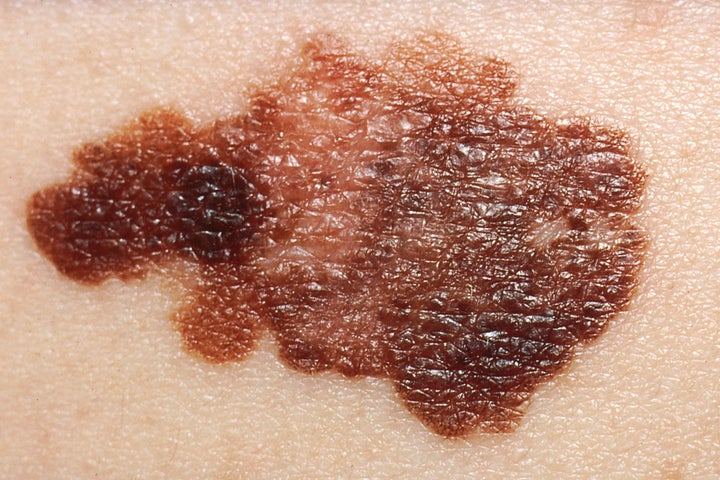
We’re here to guide you through the coronavirus pandemic. Sign up to the Life newsletter for daily tips, advice, how-tos and escapism.
Deaths from melanoma skin cancer have risen by 150% since the 1970s, according to figures released by Cancer Research UK.
Between 1971-73, there were 1.5 deaths from melanoma per 100,000 people, while between 2015-17, this rose to 3.8 deaths per 100,000 people.
The rise is greater in men than women, with death rates in men more than three times higher now than they were in the 70s. One possible reason for this is that men are more likely to be diagnosed at a later stage.
Many of these deaths could be prevented, warned the charity, which says 86% of cases are linked to spending too much time in the sun or on sun beds.
Previous figures released by the charity showed rates of melanoma have soared by 45% over the course of the last decade, with young people also developing the disease – rates for 25 to 49-year-olds have increased by 70% since the 1990s. However the issue is still most common in those aged 65 and over.
The risk of developing melanoma is around three times higher in people who are sunburnt just once every two years, it said, and even reddening of the skin or tenderness is a sign of sun damage.
Shane McCormick, previously a landscaper in the construction industry and now a sales director for paving company Talasey, was first diagnosed with skin cancer on the base of his back in April 2017.
When he was a landscape gardener, he worked outdoors most of the day alongside his dad, who also worked in the industry. “We didn’t really think about covering up or using sunscreen,” he says. “Awareness wasn’t like it is today. I used to be out there working with my top off.”
He received treatment and the results came back clear. But a year later he was diagnosed with secondary melanoma after it transpired his melanoma from the previous year had spread.
McCormick had more treatment that ended in March this year and he’ll now have yearly scans for the next five years, of which his first was clear. He changed his job because of his cancer diagnosis and is urging others to be more sun aware, too – especially given the spate of recent good weather.
“Taking care of yourself in the sun is just as important as it’s ever been,” he says. “For me this has been a big learning experience. Whilst I can’t change it, I can tell my story and stop others from experiencing what I’ve been through.”
Signs of melanoma
In the UK around 16,200 people are diagnosed each year with melanoma, making it the fifth most common cancer in the UK. Figures show that if the cancer is caught early, 91% will survive the disease for five years or more.
Melanoma can appear anywhere on the body but, according to the British Skin Foundation, is most commonly found on men’s backs and women’s legs.
It can develop from existing moles, but in 70% of cases appears as new marks on the skin. Experts recommend doing a skin check once a month.
It’s helpful to remember the ABCD rule when doing a skin check on your moles. Take note if there is:
Asymmetry: the two halves of the area differ in shape.
Border: the edges of the area may be irregular or blurred, and sometimes show notches.
Colour: this may be uneven. Different shades of black, brown and pink may be seen.
Diameter: most melanomas are at least 6mm in diameter.
Why have melanoma deaths risen?
The main reason for the rise in deaths since the 70s is the UK’s ageing population, Dr Bav Shergill, a consultant dermatologist and British Association of Dermatologists spokesperson, tells HuffPost UK.
“However other factors such as increased affordability and availability of foreign holidays, the enduring fashion for tanned skin, and the popularity of sun beds all play a part,” he says.
“Early detection is vital for successful treatment of skin cancer. Therefore, people should not delay visiting their GP if they’re concerned about a potential skin cancer. It is a major source of concern that skin cancer referrals have dropped significantly during the Covid-19 pandemic.”
Since lockdown started the UV index has repeatedly reached levels at which sun protection is advised. “It’s commonly understood that sunburn should always be avoided, however what is less well known is that a tan is also a sign of skin damage which can increase the risk of skin cancer,” says Dr Shergill.
“Short of using a self-tan product, there isn’t a safe way to get a tan.”
How to prevent melanoma
Spending time in shade, particularly between 11am and 3pm, and wearing protective clothing should be the first line of defence against the sun, says Dr Shergill. Sunscreen should be regularly applied to offer extra protection – he recommends a minimum of SPF 30, with good UVA protection.
Michelle Mitchell, Cancer Research UK’s chief executive, said: “There are many benefits to going outside, felt now more than ever because of sustained periods of lockdown. But something we should all be aware of is sun safety and how to reduce our risk of melanoma.
“Even though many summer holidays on beaches abroad have come to a halt, you can still get burnt in the UK sun. With rates rising, it’s never been more important to stay safe in the sun and contact your GP if you notice any unusual change to your skin.”